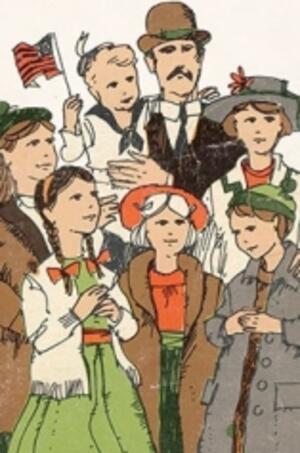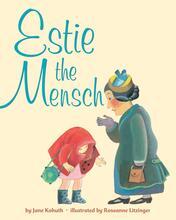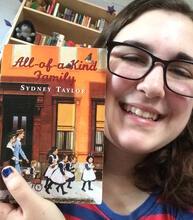Sydney Taylor
In her All-of-a-Kind Family books, Sydney Taylor created a fictional family of such endearing character and loving spirit that her young readers clamored for more. Taylor began her career as an actor and a dancer, becoming a full-time wife and mother after the birth of her daughter. All-of-a-Kind Family began as bedtime stories for her daughter; nostalgic for her childhood on the Lower East Side, Taylor wrote down the stories. Unbeknownst to her, several years later her husband submitted the manuscript for the Charles W. Follett Award for writing. It won the award, was published, and launched Taylor’s career as a writer of children’s fiction. The values of family love, charity, wisdom, compassion, and social justice that define her “All-of-a-Kind Family” owe their particular flavor to Jewish culture.
Like Louisa May Alcott, Margaret Sidney, and Mildred D. Taylor, Sydney Taylor (née Sarah Brenner) created a fictional family of such endearing character and loving spirit that her young readers clamored for more titles. In all, Taylor wrote five books about the All-of-a-Kind Family between 1951 and 1978. The values of family love, charity, wisdom, compassion, and social justice that define Taylor’s All-of-a-Kind Family owe their particular flavor to Jewish culture.
Early Life and Family
Taylor was born on October 30, 1904, and grew up on New York City’s Lower East Side. Her parents, Morris and Cecilia, of Polish and German descent, emigrated from Germany in 1901, part of a substantial wave of Jewish immigrants during that era. Morris ran a junk shop and a rag and textile business, while the bulk of the growing family’s day-to-day responsibilities fell to Cecilia. Taylor was the middle sister of five, with three younger brothers, one of whom died in infancy. While still a teenager, Sarah changed her name to Sydney, the moniker she used in her creative professional life. The family was observant but not Orthodox in their Jewish practice, and Taylor and her siblings attended public school. Her formal schooling ended two years into high school, with subsequent night school and other courses of study.
In 1925, she married pharmacist and businessman Ralph Taylor and became first an actor with the Lenox Hill Players in New York City from 1927 to 1929, then a professional dancer with the Martha Graham Dance Company during the early 1930s. Despite her successful career, she became a full-time wife and mother after the birth of her only child, Joanne (Jo), in 1935. When Jo was seven, Taylor resumed her interest in the arts, serving for much of her life as a dance and dramatics counselor at Camp Cejwin, the Jewish cultural and learning institution in upstate New York where her sister Ella (and later her other sisters) worked.
Storytelling about Immigrant Life
Although Taylor wrote several other children’s stories as well as plays (which she also directed and choreographed), nothing equaled the invention stimulated by her recollection of her own childhood as the middle daughter in a household rich in love, learning, and tradition. Eager to comfort Jo, who felt lonely at nighttime in bed, Taylor told her daughter stories about her own childhood in a family where loneliness was unheard of, since five sisters shared the same bedroom. Perhaps it is no irony that Taylor’s daughter was given the same nickname as the beloved hero Jo March in Little Women, another American classic about sisters in a warm, loving family.
As Taylor related her stories to Jo, she was flooded with nostalgia for her childhood. She found herself wanting to record her early history as the child of immigrant parents struggling to make a life for themselves among the many eager, hopeful newcomers to America in the early 1900s. The documentation was entirely personal; as she stated, “Satisfied, I promptly put the manuscript away and the years rolled over it.” Forgotten, too, was her childhood response to the inevitable question, “What do you want to be when you grow up?” She had then answered, “A writer.”
It remained for Taylor’s husband, Ralph, president of Caswell-Massey Company, a firm of chemists and perfumers, to unearth the manuscript when he heard about the Charles W. Follett Award for writing. Unknown to his wife, he submitted All-of-a-Kind Family, which was published in 1951, received the award, and launched Sydney Taylor’s career as writer of children’s fiction. The book also won the 1952 Jewish Book Council Award.
All-of-a-Kind Family
In All-of-a-Kind Family, Mama and Papa love their girls dearly and teach them to be good to one another, to their parents, to their neighbors and friends, and to their faith. Taylor gently integrates the rich traditions and heritage of Judaism into this family’s life: The reader learns about the celebration of Holiday held on the 14th day of the Hebrew month of Adar (on the 15th day in Jerusalem) to commemorate the deliverance of the Jewish people in the Persian empire from a plot to eradicate them.Purim, A seven-day festival to commemorate the Exodus from Egypt (eight days outside Israel) beginning on the 15th day of the Hebrew month of Nissan. Also called the "Festival of Mazzot"; the "Festival of Spring"; Pesah.Passover, Lit. "booths." A seven-day festival (eight days outside Israel) beginning on the 15th day of the Hebrew month of Tishrei to commemorate the sukkot in which the Israelites dwelt during their 40-year sojourn in the desert after the Exodus from Egypt; Tabernacles; "Festival of the Harvest."Sukkot, and Lit. "dedication." The 8-day "Festival of Lights" celebrated beginning on the 25th day of the Hebrew month of Kislev to commemorate the victory of the Jews over the Seleucid army in 164 B.C.E., the re-purification of the Temple and the miraculous eight days the Temple candelabrum remained lit from one cruse of undefiled oil which would have been enough to keep it burning for only one day.Hanukkah not as an aside but as a central part of religious Jewish life. Such activities as attending shul (synagogue), making a Booth erected for residence during the holiday of Sukkot.sukkah, and celebrating the weekly Sabbath are interspersed with all of the kitchen activities typical of an observant Jewish household—rolling dough for teyglekh, making gefilte fish, baking challah. When the family moves uptown to the Bronx into a predominantly gentile community, Papa and Mama remind their daughters that America promises an opportunity to advance as well as the freedom to retain one’s Jewish roots. The family’s “American-ness” was likewise cemented (at the strong urging of Taylor’s editor) through scenes such as a Fourth of July celebration. If this attention to heritage and learning sounds plodding, Taylor enlivens it always with generosity of spirit and humor. Mama reassures the family by telling them, “You don’t have to worry. … We’ll still be able to buy bagel and lox for Sunday morning breakfast.”
Two years separate each sister—named for Taylor’s own sisters—and throughout the five-book series, their personalities bring specificity and delight. The eldest, Ella, age twelve when the series begins, is serious, responsible, and lovelorn, with musical aptitude and a beautiful singing voice. Mischievous Henny, whose blonde ringlets are the envy of her sisters, is high-spirited, fun-loving, and trouble-prone. Sarah, the middle sister—Taylor’s birth-order stand-in and namesake—is studious, book-loving, and introverted, with a surprising stubborn streak; her refusal to eat rice soup complicates this rule-follower. Charlotte, second youngest, is a storyteller and daydreamer, while Gertie revels in her status as youngest—until baby brother Charlie (the real-life Irving, whose fictional name was changed for assimilatory purposes) comes along. Many readers relate especially to one sibling or another, whether in age or temperament; everyone found someone “like me.”
This point underscores the series’ charm—and its canonical status as both historical fiction and exemplary Jewish fiction for young people. The twenty-first century’s renewed movement toward “diverse books” and “own voices” (i.e., creators whose own identities are aligned with their subjects’) reflects the importance of identity representation. Taylor’s voice, that of a Jewish woman creator in the 1950s, retains its vitality, and, for many, its singularity. Indeed, a substantial number of writers and readers cite the novelty (and in some cases relief) of encountering Taylor’s work for young people about a Jewish family not suffering through the Holocaust. That the books were written soon thereafter demonstrates prescience for non-trauma narratives surrounding Judaism.
Although quotidian experiences and foibles are the series’ hallmark, world events do occasionally intrude into this sunny home, helping set the historical scene. Scarlet fever upends the Passover Lit. "order." The regimen of rituals, songs and textual readings performed in a specific order on the first two nights (in Israel, on the first night) of Passover.seder; the polio epidemic results in Aunt Lena’s paralysis; Mama’s prolonged hospital stay causes stress and worry; Ella’s beau, Jules, enlists in World War I and a friend goes missing in action; a young boy, newly orphaned, is cared for in a settlement house. Taylor was politically progressive, and examples of boundary breaking (such as Henny’s running for class president) were characterful and un-anachronistic. Likewise, instances of the family’s commitment to caring for one another and for neighbors; for looking after those who are even less fortunate than themselves; for taking responsibility for one’s actions; and for doing the right thing are comforting, believable, and non-didactically portrayed.
Some contemporary readers may approach these books about this kind and gentle family with a measure of skepticism. The characters generally act with predictable innocence and goodness, even in awkward situations (e.g., after mistakenly eating up a neighbor’s meal); there is little character development; and stereotypical family roles predominate. Mama’s place is still in the kitchen, while Papa, proprietor of a peddlers’ shop, goes out to work. The birth of a long-awaited son somewhat eclipses the importance of the family’s five energetic, engaging daughters. Even modern trends, such as the entry of women into the work force, cannot change the importance of family. The eldest sister, Ella, who is the focus of the final book in the series, ultimately chooses romantic love over a career, believing that “there’s a kind of contentment in such homely tasks [as washing dishes].” What stands the test of time is Taylor’s magical evocation of a past age when spirituality was a central part of life. We may even grieve that this era is no more.
Legacy
Sydney Taylor died of cancer on February 12, 1978. The final All-of-a-Kind Family book was published posthumously later that year. Taylor received the first annual Sydney Taylor Body-of-Work Award, established by the Association of Jewish Libraries (AJL) in 1979. Upon her death, the AJL renamed its book award—established in 1968 to recognize “outstanding books for children and teens that authentically portray the Jewish experience”—for the beloved author; in 1985 Ralph Taylor established the AJL’s Sydney Taylor Manuscript Award “to encourage aspiring authors of Jewish children’s books.” In 2019 the American Library Association incorporated the Sydney Taylor Book Award into its prestigious annual Youth Media Awards announcement, alongside such mainstays as Newbery and Caldecott Awards. That year, the Sydney Taylor Book Award winner (in the Younger Readers category) was All-of-a-Kind Family Hanukkah by Emily Jenkins, illustrated by Caldecott Medalist Paul O. Zelinsky, a picture book lovingly based on Taylor’s characters and centered on an imagined family Hanukkah celebration. In 2020 the “Sydney Taylor Schmooze” blog debuted as a project of the AJL, intended to foster discussion of Jewish children’s books. And June 2021 saw Yale University Press’s publication of From Sarah to Sydney: The Woman Behind ‘All-of-a-Kind Family’ by the late June Cummins, with Alexandra Dunietz, the fascinating and comprehensive “first and only biography of Sydney Taylor.”
Selected Works
Danny Loves a Holiday. Illustrated by Gail Owens. New York: Dutton, 1980.
Ella of All-of-a-Kind Family. Illustrated by Gail Owens. New York: Dutton, 1978.
All-of-a-Kind Family Downtown. Illustrated by Beth and Joe Krush. Chicago: Follett, 1972.
A Papa Like Everyone Else. Illustrated by George Porter. Chicago: Follett, 1966.
The Dog Who Came to Dinner. Illustrated by John E. Johnson. Chicago: Follett, 1966.
Now That You Are Eight. Illustrated by Ingrid Fetz. New York: Association Press, 1963.
Mr. Barney’s Beard. Illustrated by Charles Geer. Chicago: Follett, 1961.
All-of-a-Kind Family Uptown. Illustrated by Mary Stevens. Chicago: Follett, 1958.
More All-of-a-Kind Family. Illustrated by Mary Stevens. Chicago: Follett, 1954.
All-of-a-Kind Family. Illustrated by Helen John. Chicago: Follett, 1951.
“The All-of-a-Kind Family Companion” (PDF) Prepared by The Association of Jewish Libraries, 2004. https://jewishlibraries.org/images/downloads/Sydney_Taylor_Book_Award/companion.pdf
Berger, Laura Stanley, ed. Twentieth Century Children’s Writers. 4th ed. Detroit: St. James Press, 1995.
Commire, Anne, ed. Something about the Author. Vols. 26, 28. Detroit: Gale, 1982.
Cummins, June. “Becoming an ‘All-of-a-Kind’ American: Sydney Taylor and Strategies of Assimilation.” The Lion and the Unicorn, vol. 27, no. 3 (September 2003): 324-343.
Cummins, June, with Dunietz, Alexandra. From Sarah to Sydney: The Woman Behind ‘All-of-a-Kind Family.’ New Haven: Yale University Press, 2021.
Cummins, June. “Leaning Left: Progressive Politics in Sydney Taylor’s All-of-a-Kind Series.” Children’s Literature Association Quarterly, vol. 30, no. 4 (Winter 2005): 386-408.
Cummins, June “Sydney Taylor: A Centenary Celebration.” The Horn Book Magazine, vol. LXXXI, no. 3 (March/April 2005): page 231-234.
Diner, Hasia R. Lower East Side Memories: A Jewish Place in America. Princeton, NJ: Princeton University Press, 2000.
Eichler-Levine, Jodi. Suffer the Little Children: Use of the Past in Jewish and African American Children’s Literature. New York: New York University Press, 2013.
Flax, Shoshana. “Which All-of-a-Kind Family Sibling Are YOU?” The Horn Book, Inc. January 6, 2015. https://www.hbook.com/?detailStory=kind-family-sibling-you
Fuller, Muriel, ed. More Junior Authors. New York: H.W. Wilson Col, 1963.
Hollowell, Lillian, ed. A Book of Children’s Literature. 3d ed. New York: Holt, Rinehart & Winston, 1966.
Hopkins, Lee Bennett. More Books by More People. New York: Citation Press, 1974.
Locher, Frances Carol, ed. Contemporary Authors. Vols. 77–80. Detroit: Gale, 1979.
Rabinowitz Heidi, and Sadaf Siddique. “We Need Diverse Jewish and Muslim Books: A Conversation.” The Horn Book Magazine, vol. XCVI, no. 2 (March/April 2020): pages 12-18.
Schneider, Emily. “Epidemic in the City: Illness and Disability in Sydney Taylor’s More All-of-a-Kind Family.” Jewish Book Council. November 2, 2020. https://www.jewishbookcouncil.org/pb-daily/epidemic-in-the-city-illness-and-disability-in-sydney-taylors-more-all-of-a-kind-family
“The Sydney Taylor Book Award: About the Award.” The Association of Jewish Libraries. https://jewishlibraries.org/content.php?page=Sydney_Taylor_Book_Award___About_the_Award
Silvey, Anita, ed. Children’s Books and Their Creators. Boston: Houghton Mifflin, 1995.
Ward, Martha E., et al. Authors of Books for Young People. 3d ed. Metuchen, NJ: Scarecrow Press, 1990).







